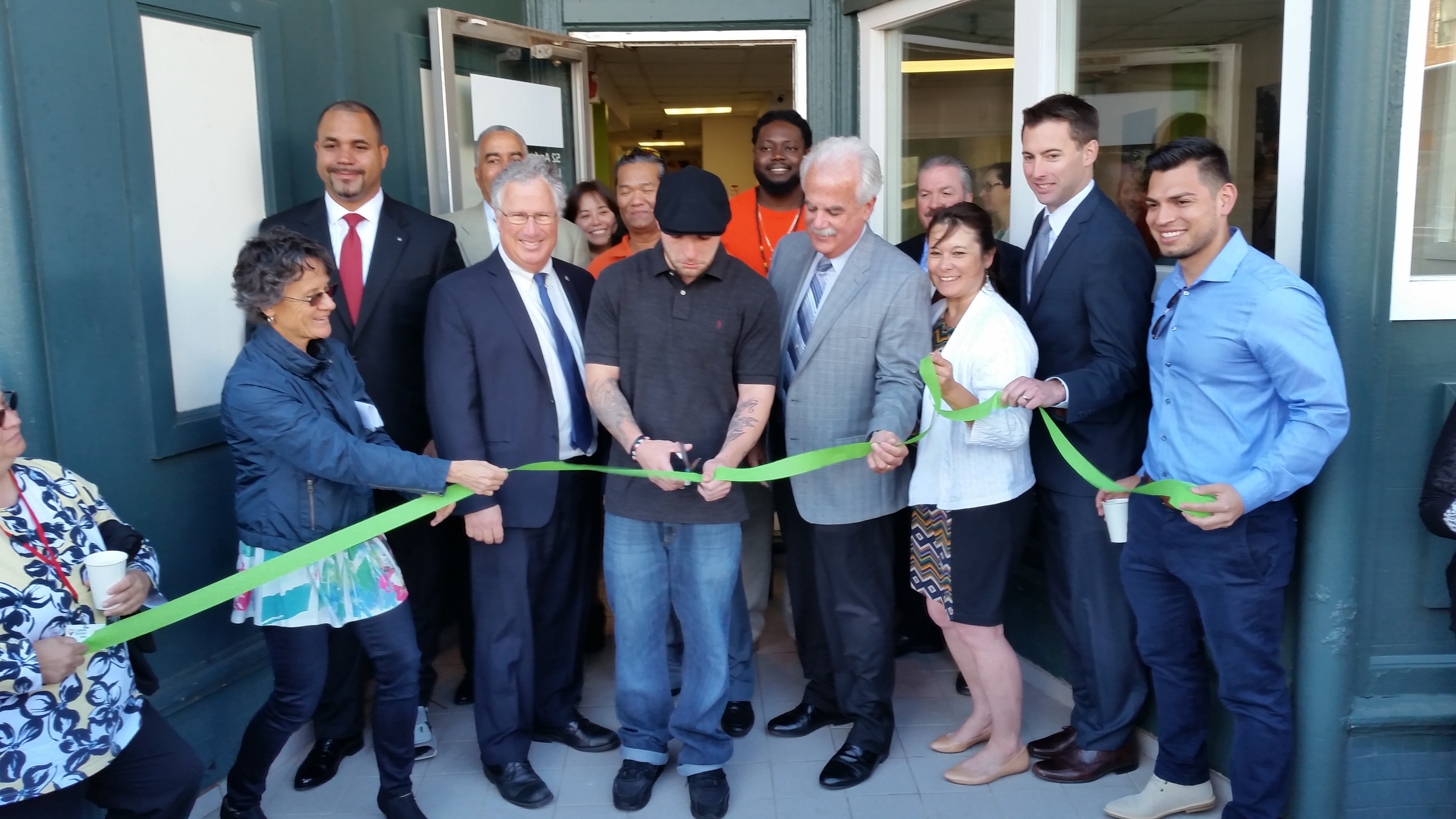At the June 13 opening of the Roca Center in Lynn, Massachusetts – amid a crowd of police and state officials – Chris Mullins, 24, addressed the impact of Roca on his life.
Roca (Spanish for “rock”) is a non-profit organization that provides a foundation for high-risk young people to gain control of their actions and break the cycle of drugs, crime, and incarceration.
“My whole life was a mess,” said Mullins, an East Lynn native. Fueled by pills, cocaine and alcohol and with a criminal record of drug possession, he explained, “I had no regard for my life or the life of anyone around me.”
Before cutting the ribbon of the new facility, Mullins revealed how much has changed for the better since Roca first reached out to him. “It’s been over a year since getting high,” he said. Along with learning new skills and job training, Mullins has found a place of belonging with Roca. “It’s more than just a program,” he said. “It’s a family.”
IN THIS PHOTO: CUTTING OF THE RIBBON OF ROCA CENTER IN LYNN, MASSACHUSETTS
Reputation for Success
Founded in 1988 in Chelsea, Massachusetts, Roca has demonstrated incredible results for more than 18,000 people in the Greater Boston area and across the state. The non-profit currently works with 700 high-risk young men (ages 17-23) and 200 high-risk young mothers (ages 12-24). By building relationships and trust, Roca re-engages these individuals out of violence and crime and facilitates life skills, education and employment.
Roca has unprecedented numbers of success through its outcome-driven program. In 2015, 98% of the 659 young men enrolled in Roca did not serve time in prison, and 92% were employed for at least three months.
The non-profit’s performance has led to the largest “Pay for Success” initiative in the country. In 2014, $27 million was allocated from the government and financial firms to pay for the positive outcomes of these high-risk youth, which, in turn, offsets the state costs of incarceration.
Related article: “TREATING THE WHOLE INDIVIDUAL AT INTEGRITY HOUSE”
Resistance to Change
The transition isn’t easy. Roca engages with individuals who have no other place to go. Most have never completed high school or held a job. They have a history of offenses and no social support system to fall back on.
Roca Founder and CEO Molly Baldwin addressed this at the Lynn center opening, drawing a comparison to kids who apply themselves and seek a better future with those who go to Roca: “It is much harder to spend time with young people who are really struggling. It is not easy to have people put guns away. You can’t just tell them. Drugs don’t just disappear.”
“If our young people were ready, willing and able to change, they wouldn’t be our young people,” said Emily Fish, Project Coordinator at the Lynn center. “Mental health issues are a challenge. Substance abuse is a huge challenge, especially in the North Shore, especially in Lynn.”
To combat the pervasive effects of drug abuse and crime in the community, Roca has partnered with the Essex County Sheriff’s Department, the Executive Office of Health and Human Services, and the Massachusetts Probation Department. Baldwin said, “We spend as much time with them as we do with young people [in the program].”
Fifty of the 100 Roca participants in Lynn will be referred from the police department, and the remaining 50 from the sheriff’s department – or jail – and through extensive outreach.
The outreach means youth workers getting in vans every day and knocking on people’s doors. The ensuing insults and door-slamming in response to these outreach efforts is met with more outreach. “When they tell us to go away, or try so desperately to avoid us,” said Baldwin, “we show up again.”
Haven From the Streets
Once enrolled in Roca, for six months the participants start to build relationships with the staff and trust with the program.
“We’re there to help them guide through their shortcomings, or what they think their shortcomings are,” said Elisee Pompilus, Youth Worker at the Lynn facility. “A lot of them just don’t have any motivation, and don’t have any value of themselves, for whatever reason in their circumstances, and we drill that. We iterate the-world-is-yours type of mentality. You got to make that first step, and continue to walk, and eventually you’re going to be sprinting.”
Peacemaking circles occur for three days, bringing together the new participants with policemen, probation officers and community members – giving each a chance to be heard. Unwilling and silent at first, the participants tend to find their voice by the third day, shedding light on the other side of crime and law enforcement.
Yotam Zeira, Roca’s Director of External Affairs, explained, “You hear young men saying they never thought about police like that in the past, and you hear policemen say it’s the first time that they hear this kind of perspective. You hear probation officers saying similar things.”
After six months of short-term outcomes such as increased engagement in lessons and a decrease in substance abuse, the next twelve months further sustain that working relationship with staff and ingrain new ways to look at behavior, such as being able to differentiate and understand the relationship between thoughts, emotions and actions.
For a full mindmap containing additional related articles and photos, visit #roca
The Transitional Employment Program is introduced at 18 months in the program, challenging participants with what might be their first job, such as cleaning public parks for six-and-a-half hours a day, four days a week – with hours paid by Roca through state contracts. Success during this transition leads to full-time employment with local companies that work with Roca and are undeterred by a participant’s past offenses. In the following two years, Roca checks in and gives counsel to the former participants as they complete their transition from crime to employment.
We tell young people they matter. We invite them to participate in their own lives.
Trajectory Challenges
The transformation – disrupting dangerous behavior and habits to instill discipline and skills – is no smooth ride. Hostility toward change, drug relapses and probation violations are just a few obstacles for development in the program.
“Any good thing takes work, and it takes a long time. I think this is really risky business on every level,” said Baldwin. “How do you keep kids safe?” Along with social media amplifying gang disputes, Baldwin acknowledged that there are many more guns available on the street.
A gang member who goes to the Roca headquarters in Chelsea may come armed. This dangerous action is addressed later in a safety circle of participants and staff. Questions of safety and vulnerability – such as “How do you feel safe when there is a gun in this space?” – are unpacked and answered.
In the Photo: Roca Circle
The web-based software “Efforts Toward Outcomes” (ETO) is a key part in measuring progress, trends and setbacks at Roca. “We track everything,” said Fish in the Youth Workers’ office in Lynn. For example, she said, “Every time you see this young person three times a week, he also does educational services.” When not at Roca as often, he doesn’t. ETO is a motivational tool that measures development based on evidence and tracks the trends that lead toward progress.
When there are setbacks, Roca is resolute in sustaining that relationship. Youth workers search for participants who disappear. They find them when they relapse or are behind bars. Roca remains adamant in its support to bring about positive change, no matter the pitfalls along the way.
Building Up and Out
“The question is, How do you help young people feel that they belong?” said Baldwin in a Lesley University commencement speech in Cambridge last month. She addressed the crux of Roca’s mission: “We tell young people they matter. We invite them to participate in their own lives.”
Roca has transformed thousands of lives in communities across the state, and there are plans to expand its mission outside of Massachusetts. Chris Mullins at the Lynn opening ceremony just gave a glimpse of what Roca can do to create a sense of belonging and purpose where there was none before.
Recommended reading: “TOP 10 HIGHLIGHTS FROM ROCA’S CRIMINAL JUSTICE REPORT”
_ _
Featured Image: Roca Ribbon Cutting













